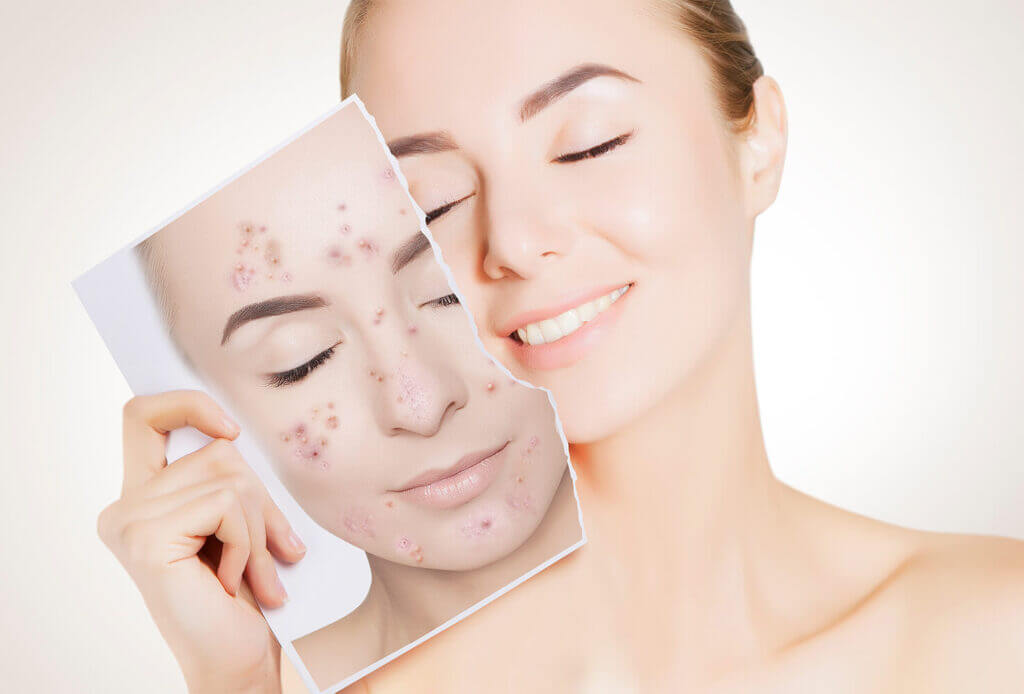ABOUT SKIN
Adult acne, the five most important things you need to know to get rid of it sooner.
Among the skin problems we are experiencing, there is a skin disease that relapses more frequently than other skin diseases, causes scars or marks, and causing pain for many people, from adolescence to adulthood.
That’s right, as you already predict, it’s ‘Acne’.
People who have not experienced the stress and pain of adult acne that continues to recur despite being an adult, not a teenager, will not know how terrible it is.
First of all, because many people are confused with Acne and Pimple, I will define it right and continue to write this article.
The difference between acne and pimple is that acne is a disease and pimple is one of its symptoms.
- Whiteheads (closed plugged pores)
- Blackheads (open plugged pores)
- Small red, tender bumps (papules, a single bump is called a comedo)
- Pimples (pustules), which are papules with pus at their tips
- Large, solid, painful lumps under the skin (nodules)
- Painful, pus-filled lumps under the skin (cystic lesions)
In general, people think acne appears briefly in adolescence and then disappears when they become adults.
However, it is known as most adults have experienced acne once or still suffer from it and that it is more common in women than in men.
In the case of the United States, it is reported that ‘Acne affects 80% of Americans at some time during their lives.
It is best to continue acne treatment steadily through dermatologists, but there are not many people who do so in reality because they do not have enough time or enough money to do so.
So let’s look at the causes and characteristics of adult acne from now on and see how we can minimize acne occurrence while we are in our daily lives.
The causes of adolescent acne are generally about four.
- Increased secretion of sebum
- Clogged pores
- Excessive skin exposure to acne bacteria (Staphylococcus Aureus, C. acnes)
- Reaction to skin inflammation
You may already be well aware of these causes.
However, in the case of adult acne, the characteristics and symptoms are slightly different.
Characteristics of adult acne
- More common in women than men(More than 80 % are women).
- Likely to occur in areas where sebaceous glands such as the face, neck, back, and chest have developed, there are many large acne in the cheek area and jaw area.
- Characterized by a large amount of inflammation and small size of comedo.
- Leave scars if not treated in time.
Cause of adult acne
-
Chronic stress
-
Misuse of cosmetics
-
Damage to the skin barrier
-
High sugar & high-fat food intake
-
Smoking and drinking
-
Bad lifestyle: Irregular eating habits, Sleep deprivation
-
The effects of hormones during pregnancy or menstruation.
We should try to get out of the above causes 1,5, 6 to escape the pain of adult acne but this time, I would like to give you more detail on 2, 3, and 4, which are relatively easy to correct compared to 1, 5, and 6.
A team of Korean dermatologists published the results of an analysis of ‘Relationship between acne and the use of cosmetics’ on 539 acne patients in the Journal of Cosmetic Dermatology, an international academic journal, in November 2020.
They divided the patients into two groups as follows to find out their use of cosmetics.
- Group A: a group of patients who visited their dermatology clinic due to poor treatment progress at other dermatology clinics: 328 patients
- Group B: a group of patients who visited their dermatology clinic for the first time for acne treatment: 210 patients
They obtained the following analysis results.
The above results show that people who often wear color makeup get more acne and having a lot of trouble treating it.
People with acne should be careful about putting on makeup. In particular, if you do double cleansing your face, it irritates the skin excessively and damages the skin barrier, which can make acne worse.
If you must wear color makeup, use powder type rather than liquid type.
The skin barrier always tries to keep it moist to protect the skin, but if the skin suddenly dries up and collapses this barrier, get dead skin cells on the surface of your skin, inflammatory lesions appear. As a result, this inflammation worsens into acne.
When the skin barrier suddenly collapses, it is necessary to calm the skin and moisturize it to restore the skin barrier in the early stage.
On June 10, 2020, the study results were published in JAMA Dermatology, a dermatological journal of the American Medical Association, that milk, high-fat foods, and high-sugar foods affect the aggravation of adult acne.
The team that conducted the study recruited 24,452 French adults and analyzed their acne status, health, and eating habits.
Study results have shown that eating high-fat & high-sugar foods is associated with adult acne.
In addition, research participants with adult acne eat foods, beverages, and milk that contain more fat and sugar (including chocolate) than those with clean skin, the study found.
The researchers repeated the analysis taking into account the conditions in women who were more affected by hormones.
However, the results were the same, as the more frequent intake of a diet rich in sugar, high fat, and dairy products worsened adult acne.
Conversely, foods that reduce the risk of adult acne include fruits, vegetables, and fish.
So how do we get out of this persistent acne?
Let’s look at the five principles that we must follow to escape the pain of adult acne.
1. Clean cleansing considering your skin barrier
You must wash away the sebum and waste without squeezing pimples because forcing your hand to squeeze pimples can increase inflammation and lead to acne scarring.
And if you put on color makeup to cover acne or acne scars, you should wash them off more meticulously because the color cosmetics can block your pores and make acne worse.
If you are doing double cleansing that is cleansing twice using oil and water-based cleanser, it is good not to wash your face like that because it can damage your skin barrier by overly irritating your skin and make acne worse.
2. Do not use oil cleansers that may leave residue on your skin.
Cleansing is a very important factor in acne.
If you don’t wash away all the dust, cosmetic residue, sweat, and sebum on your skin properly, they will get tangled on your skin to block pores and cause acne.
Above all, if you don’t remove the color makeup properly, inflammation gets worse or you may get comedone.
Especially if you’re an acne sufferer, you shouldn’t use an oil cleanser to remove makeup.
You’d better use light cleansers such as foam types or powder types that contain antibacterial ingredients and are less oily and irritating because oil remains on your skin and is likely to cause problems.
You should also pay more attention to the areas around your nose or hairline where makeup residue is likely to remain and wash them clean.
When you wash your face, avoid rubbing too hard or exfoliating too much, as this can irritate your skin and lead to inflammation.
3. Use cosmetics that contain ingredients that can relieve acne.
It is helpful for people with adult acne to use products containing Tea Tree Oil, Salicylic Acid, Azelaic Acid, Niacinamide, Zinc-PCA, and Piroctone Olamine that have skin-soothing and anti-inflammatory effects.
Tea Tree Oil is known to have anti-inflammatory and antibacterial effects, Salicylic Acid effectively dissolves dead skin cells, and Azelaic Acidacid helps soothe inflammation.
Niacinamide, known as a whitening ingredient, is very effective in relieving inflammation.
The Zinc-PCA, a natural moisturizing factor, controls sebum secretion because it kills acne germs, reduces sebum secretion, and minimizing enlarged pores.
In addition, Piroctone Olamine, an antibacterial component, eliminates the causative bacteria of acne and controls sebum secretion.
For women in their 20s who have greatly increased the types of cosmetics they use, it is good to check ingredients thoroughly when purchasing cosmetics because more ingredients come into contact with their skin, which is more likely to cause skin irritation.
4. Avoid cosmetics that contain five ingredients that aggravate your acne.
Typical ingredients that adversely affect acne include Bees Wax, Olive Oil, Coconut Oil, Peanut Oil, and Petrolatum.
These ingredients can exacerbate acne by supplying oil to oily skin and increasing sebum secretion, so if you have acne, you should refrain from using cosmetics containing these ingredients.
5. Should eat foods that help you improve your acne.
Vitamin A, Vitamin B (such as B2 and B6), Vitamin C, and other minerals-rich vegetables and fruits such as cabbages, lettuces, carrots, tomatoes, apples, and grapes help improve acne.
In addition, fish containing omega-3 can help improve acne.
However, high-fat and high-sugar foods that increase sebum secretion such as chocolates, dairy products, and junk foods make acne worse, as shown in the above results, if possible, so it is better to avoid eating such foods.
And having regular eating habits helps relieve acne.













